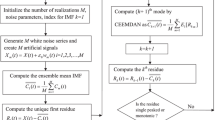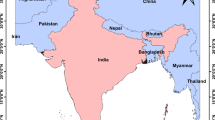Abstract
Brightness temperature observations from Microwave Sounding Unit and Advanced Microwave Sounding Unit-A (AMSU-A) on board National Oceanic and Atmospheric Administration (NOAA) satellites have been widely utilized for estimating the global climate trend in the troposphere and stratosphere. A common approach for deriving the trend is linear regression, which implicitly assumes the trend being a straight line over the whole length of a time series and is often highly sensitive to the data record length. This study explores a new adaptive and temporally local data analysis method—Ensemble Empirical Mode Decomposition (EEMD)—for estimating the global trends. In EEMD, a non-stationary time series is decomposed adaptively and locally into a sequence of amplitude-frequency modulated oscillatory components and a time-varying trend. The AMSU-A data from the NOAA-15 satellite over the time period from October 26, 1998 to August 7, 2010 are employed for this study. Using data over Amazon rainforest areas, it is shown that channel 3 is least sensitive to the orbital drift among four AMSU-A surface sensitive channels. The decadal trends of AMSU-A channel 3 and other eight channels in the troposphere and stratosphere are deduced and compared using both methods. It is shown that the decadal climate trends of most AMSU-A channels are nonlinear except for channels 3–4 in Northern Hemisphere only and channels 12–13. Although the decadal trend variation of the global average brightness temperature is no more than 0.2 K, the regional decadal trend variation could be more (less) than 3 K (−3 K) in high latitudes and over high terrains.















Similar content being viewed by others
References
Angell JK, Korshover J (1983) Global temperature variations in the troposphere and stratosphere, 1958–1982. Mon Weather Rev 111(5):901–921
Barnett TP (1984) Long-term trends in surface temperature over the oceans. Mon Weather Rev 112:303–312
Breaker LC, Ruzmaikin A (2011) The 154-year record of sea level at San Francisco: extracting the long-term trend, recent changes, and other tidbits. Clim Dyn 36:545–559. doi:10.1007/s00382-010-0865-4
Christy JR, Spencer RW, Lobel ES (1998) Analysis of the merging procedure for the MSU daily temperature time series. J Clim 11:2016–2041
Christy JR, Spencer RW, Braswell WD (2000) MSU tropospheric temperatures: dataset construction and radiosonde comparisons. J Atmos Oceanic Technol 17:1153–1170
Christy JR, Spencer RW, Norris WB, Braswell WD, Parker DE (2003) Error estimates of version 5.0 of MSU–AMSU bulk atmospheric temperature. J Atmos Oceanic Technol 20:613–629
Comiso JC, Parkinson CL (2004) Satellite-observed changes in the Arctic. Phys Today 57(8):38–44
Delgado JM, Apel H, Merz B (2010) Flood trends and variability in Mekong River. Hydrol Earth Syst Sci 14:407–418
Eskridge RE, Luers JK, Redder CR (2003) Unexplained discontinuity in the U.S. radiosonde temperature data. Part I: troposphere. J Climate 16:2385–2395
Fan J, Yao Q (2003) Nonlinear time series. Springer, New York
Flandrin P, Rilling G, GonÇalvès P (2004) Empirical mode decomposition as a filter bank. IEEE Signal Process Lett 11:112–114
Folland CK, Parker DE, Kates FE (1984) Worldwide marine temperature fluctuations, 1856–1981. Nature 310:670–673
Franzke C (2009) Multi-scale analysis of teleconnection indices: climate noise and nonlinear trends. Nonlinear Processes Geophys 16:65–76
Franzke C (2010) Long-range dependence and climate noise characteristics of Antarctic temperature data. J Climate 23:6074–6081. doi:10.1175/2010JCLI3654.1
Gaffen DJ (1996) A digitized metadata set of global upper-air station histories. NOAA Tech. Memo. ERL
Goldberg M, Ohring G, Butler J, Cao C, Datla R, Doelling D, Gärtner V, Hewison T, Iacovazzi B, Kim D, Kurino T, Lafeuille J, Minnis P, Renaut D, Schmetz J, Tobin D, Wang L, Weng F, Wu X, Yu F, Zhang P, Zhu T (2011) The global space-based inter-calibration system (GSICS). Bull Am Meteorol Soc (accepted)
Goodrum G, Kidwell KB, Winston W (2009) NOAA KLM user’s guide. National Clim Data Center (available online at http://www2.ncdc.noaa.gov/docs/klm/index)
Grody NC, Vinnikov KY, Goldberg MD, Sullivan JT, Tarpley JD (2004) Calibration of multisatellite observations for climate studies: microwave Sounding Unit (MSU). J Geophys Res 109:D24104. doi:10.1029/2004JD005079 (ARL-211, 38 pp)
Hansen JE, Lebedeff S (1987) Global trends of measured surface air temperature. J Geophys Res 92:13345–13372
Hansen J, Johnson D, Lacis A, Lebedeff S, Lee P, Rind D, Russell G (1981) Climate impact of increasing atmospheric carbon dioxide. Science 213:957–966. doi:10.1126/science.213.4511.957
Hansen J, Ruedy R, Glascoe J, Sato M (1999) GISS analysis of surface temperature change. J Geophys Res 104:30997–31022
Härdle W (1990) Applied nonparametric regression. Cambridge University Press, Cambridge
Huang NE, Wu Z (2008) A review on Hilbert-Huang transform: method and its applications to geophysical studies. Rev Geophys 46:RG2006
Huang NE, Shen Z, Long RS et al (1998) The empirical mode decomposition and the Hilbert spectrum for nonlinear and non-stationary time series analysis. Proc R Soc Lond 454A:903–995
Jones PD (1995) Recent variations in mean temperature and the diurnal temperature range in the Antarctic. Geophy Res Lett 22(11):1345–1348
Jones PD, Wigley TML, Kelly PM (1982) Variations in surface air temperatures, part 1: northern hemisphere, 1881–1980. Mon Weather Rev 110:59–70
Jones PD, Raper SCB, Bradley RS, Diaz HF, Kelly PM, Wigley TML (1986) Northern Hemisphere surface air temperature variations, 1851–1984. J Clim Appl Met 25:161–179
Jones PD, New M, Parker DE, Martin S, Rigor IG (1999) Surface air temperature and its changes over the past 150 years. Rev Geophys 37:173–199
Karl TR, Tarpley JD, Quayle RG, Diaz HF, Robinson DA, Bradley RS (1989) The recent climate record: What it can and cannot tell us. Rev Geophys 27:405–430
Lee T, Ouarda TBMJ (2010) Long-term prediction of precipitation and hydrologic extremes with nonstationary oscillation processes. J Geophys Res 115:D13107. doi:10.1029/2009JD012801
Lee T, Ouarda TBMJ (2011) Prediction of climate nonstationary oscillation processes with empirical mode decomposition. J Geophys Res 116:D06107. doi:10.1029/2010JD015142
Liang MC, Li KF, Shia RL, Yung YL (2008) Short-period solar cycle signals in the ionosphere observed by FORMOSAT-3/COSMIC. Geophys Res Lett 35:L15818. doi:10.1029/2008GL034433
Luers JK, Eskridge RE (1995) Temperature corrections for the VIZ and Vaisala radiosondes. J Appl Meteor 34:1241–1252
Mears CA, Wentz FJ (2005) The effect of diurnal correction on the satellite-derived lower tropospheric temperature. Science 309:1548–1551
Mears CA, Wentz FJ (2009) Construction of the remote sensing systems V3.2 atmospheric temperature records from the MSU and AMSU microwave sounders. J Atmos Oceanic Technol 26:1040–1056
Mears CA, Schabel MC, Wentz FJ (2003) A reanalysis of the MSU channel 2 tropospheric temperature record. J Climate 16:3650–3664
Mo T (1996) Prelaunch calibration of the advanced microwave sounding unit-A for NOAA-K. IEEE Trans Microw Theory Technol 44:1460–1469. doi:10.1109/22.536029
Mo T (1999) AMSU-A antenna pattern corrections. IEEE Trans Geosci Remote Sens 37:103–112
Mo T (2007) Diurnal variation of the AMSU-A brightness temperatures over the Amazon rainforest. IEEE Trans Geosci Remote Sens 45:958–969
Mo T (2009) A study of the NOAA-15 AMSU-A brightness temperatures from 1998 through 2007. J Geophys Res 114:D11110. doi:10.1029/2008JD011267
Ohring G, Wielicki B, Spencer R, Emery B, Datla R (eds) (2004) Satellite instrument calibration for measuring global climate change. NIST Rep. NISTIR 7047, 101 pp
Paltridge G, Woodruff S (1981) Changes in global surface temperature from 1880 to 1977 derived from historical records of sea surface temperature. Mon Weather Rev 109:2427–2434
Parey S, Dacunha-Castelle D, Hoang TTH (2010) Mean and variance evolutions of the hot and cold temperatures in Europe. Clim Dyn 34:345–359
Peterson TC, Karl TR, Jamason PF, Knight R, Easterling DR (1998) The first difference method: maximizing station density for the calculation of long-term global temperature change. J Geophys Res Atmos 103(D20):25967–25974
Qian C, Fu C, Wu Z, Yan Z (2009) On the secular change of spring onset in Stockholm. Geophys Res Lett 36:L12706. doi:10.1029/2009GL038617
Qian C, Yan ZW, Wu Z, Fu CB, Tu K (2011) Trends in temperature extremes in association with weather-intraseasonal fluctuations in eastern China. Adv Atmos Sci 28:297–309. doi:10.1007/s00376-010-9242-9
Quayle RG et al (1999) An operational near-realtime global temperature index. Geophys Res Lett 26:333–335
Redder CR, Luers JK, Eskridge RE (2004) Unexplained discontinuity in the U.S. radiosonde temperature data. Part II: stratosphere. J Atmos Oceanic Technol 21:1133–1144
Ruzmaikin A, Feynman J (2009) Search for climate trends in satellite data. Adv Adap Data Anal 1:667–679
Ruzmaikin A, Santee ML, Schwartz MJ, Froidevaux L, Pickett H (2007) The 27-day variations in stratospheric ozone and temperature: New MLS data. Geophys Res Lett 34:L02819. doi:10.1029/2006GL028419
Stock JH, Watson MW (1988) Variable trends in economic time series. J Econ Perspect 2:147–174
Türkeş M, Tatli H (2009) Use of the standardized precipitation index (SPI) and a modified SPI for shaping the drought probabilities over Turkey. Int J Climatol 29:2270–2282. doi:10.1002/joc.1862
Vinnikov KY, Grody NC (2003) Global warming trend of mean tropospheric temperature observed by satellites. Science 302:269–272
Wu Z, Huang NE (2004) A study of the characteristics of white noise using the empirical mode decomposition method. Proc R Soc Lond 460A:1597–1611
Wu Z, Huang NE (2005) Ensemble empirical mode decomposition: a noise-assisted data analysis method. COLA technical report 193. ftp://grads.iges.org/pub/ctr/ctr_193.pdf
Wu Z, Huang NE (2009) Ensemble empirical mode decomposition: a noise-assisted data analysis method. Adv Adapt Data Anal 1(1):1–41
Wu Z, Huang NE, Long SR, Peng CK (2007) On the trend, detrending and variability of nonlinear and non-stationary time series. Proc Natl Acad Sci USA 104:14889–14894
Wu Z, Huang NE, Chen X (2009) The multi-dimensional ensemble empirical mode decomposition method. Adv Adapt Data Anal 1(3):339–372
Wu Z, Huang NE, Wallace JM, Smoliak BV, Chen X (2011) On the time-varying trend in global-mean surface temperature. Clim Dyn 37:759–773. doi:10.1007/s00382-011-1128-8
Zou CZ, Goldberg MD, Cheng Z, Grody NC, Sullivan JT, Cao C, Tarpley D (2006) Recalibration of microwave sounding unit for climate studies using simultaneous nadir overpasses. J Geophys Res 111:D19114. doi:10.1029/2005JD006798
Zou CZ, Gao M, Goldberg M (2009) Error structure and atmospheric temperature trend in observations from the microwave sounding unit. J Climate 22:1661–1681
Acknowledgments
This work was supported by Chinese Ministry of Science and Technology under 973 project 2010CB951600.
Author information
Authors and Affiliations
Corresponding author
Rights and permissions
About this article
Cite this article
Qin, Z., Zou, X. & Weng, F. Comparison between linear and nonlinear trends in NOAA-15 AMSU-A brightness temperatures during 1998–2010. Clim Dyn 39, 1763–1779 (2012). https://doi.org/10.1007/s00382-012-1296-1
Received:
Accepted:
Published:
Issue Date:
DOI: https://doi.org/10.1007/s00382-012-1296-1




